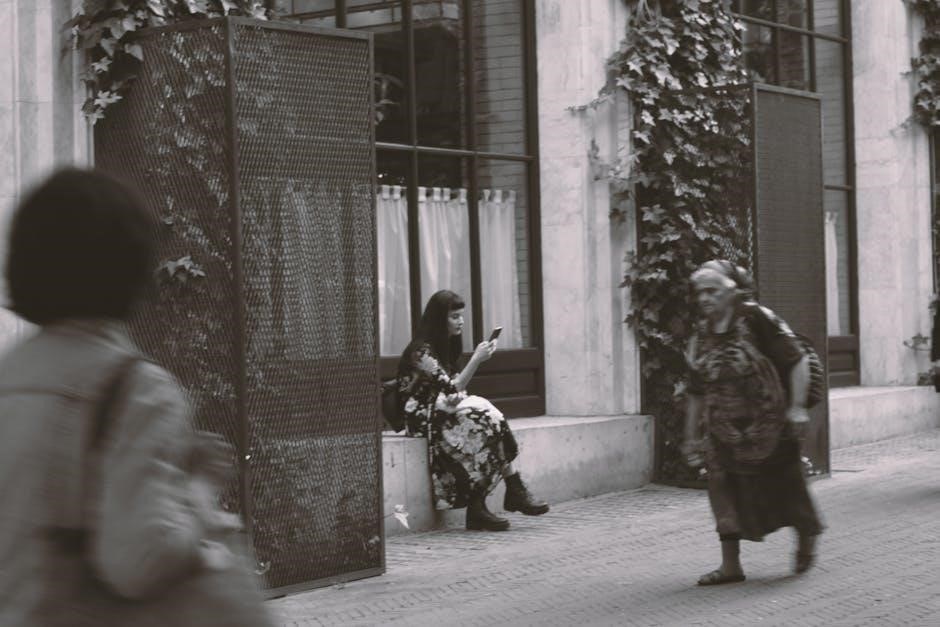The Devil in the White City reading guide offers a roadmap for exploring Erik Larson’s captivating non-fiction novel, examining the contrasting lives of Daniel Burnham and H.H. Holmes.
1.1 Overview of the Book
The Devil in the White City by Erik Larson is a captivating non-fiction novel that intertwines the stories of Daniel Burnham, the architect behind the 1893 World’s Columbian Exposition, and H.H. Holmes, the first modern serial killer. Set against the backdrop of Chicago’s transformative period, the book explores themes of ambition, innovation, and crime; Larson masterfully weaves historical events, such as the construction of the “White City” and Holmes’ sinister activities, into a narrative that highlights the duality of progress and darkness during the Gilded Age. The book is both a tribute to architectural brilliance and a chilling account of evil.
1.2 Historical Context: The 1893 World’s Columbian Exposition
The 1893 World’s Columbian Exposition in Chicago was a pivotal event in American history, showcasing innovation and culture. It marked the 400th anniversary of Columbus’ arrival, attracting millions. The fair highlighted Chicago’s rise as a major city, overcoming challenges like urban growth and social unrest. Architect Daniel Burnham led its construction, symbolizing hope and progress. This event set the stage for the duality explored in The Devil in the White City, contrasting the fair’s grandeur with the darker underside of society, epitomized by H.H. Holmes’ crimes. The exposition’s legacy endures as a symbol of American ambition and ingenuity.
1.3 The Dual Narrative: Daniel Burnham and H.H. Holmes
Erik Larson’s The Devil in the White City masterfully intertwines the stories of Daniel Burnham and H.H. Holmes, creating a compelling dual narrative. Burnham, the visionary architect, represents ambition and innovation, driving the creation of the White City for the 1893 World’s Columbian Exposition. In stark contrast, Holmes, the serial killer, embodies deception and darkness, preying on victims amidst the fair’s splendor. Their lives, though seemingly unrelated, symbolize the duality of human nature—progress and horror coexisting in the Gilded Age. This contrasting narrative captivates readers, offering insights into the era’s grandeur and its shadowy underbelly. Larson’s approach highlights the tension between light and dark, making the book a gripping exploration of history and humanity.

The Plot and Structure
The book masterfully alternates between the construction of the White City and the sinister crimes of H.H. Holmes, creating a gripping narrative of creation and destruction.
2.1 The Story of Daniel Burnham and the Construction of the White City
Daniel Burnham’s journey in constructing the 1893 World’s Columbian Exposition showcases his architectural brilliance and relentless ambition. Facing numerous challenges, Burnham led a team of visionary architects to create the iconic White City, a symbol of hope and progress. The fair’s grandeur, with its dazzling architecture and innovative designs, not only elevated Chicago’s status but also represented the pinnacle of American achievement during the Gilded Age. Burnham’s dedication and leadership transformed the impossible into reality, leaving a lasting legacy in American history and architecture.
2.2 The Life and Crimes of H.H. Holmes
H.H. Holmes, one of America’s first modern serial killers, terrorized Chicago during the 1893 World’s Columbian Exposition. Using his charm and intelligence, he lured victims into his “murder castle,” a hotel equipped with secret passages, hidden rooms, and lethal traps. Holmes preyed on unsuspecting visitors, exploiting the city’s bustling atmosphere. His crimes, marked by deception and brutality, contrast sharply with the fair’s grandeur. Larson’s meticulous research reveals Holmes’ psychological complexity, while the reading guide delves into the societal factors that enabled his reign of terror, offering a chilling glimpse into the darker side of human nature.
2.3 The Intersection of Architecture and Murder
The Devil in the White City explores the chilling intersection of architecture and murder through H.H. Holmes’ “murder castle,” a hotel designed with secret passages, hidden rooms, and lethal traps. While Daniel Burnham’s White City symbolized innovation and progress, Holmes’ structure embodied darkness and deception. Larson highlights how the hotel’s design facilitated Holmes’ crimes, blending seamlessly into the bustling World’s Fair environment. The guide examines how architecture served dual purposes—celebration and horror—underscoring the duality of human ingenuity and depravity during the Gilded Age. This juxtaposition remains a haunting reminder of the era’s contradictions.

Major Themes
The Devil in the White City explores themes of ambition, crime, and the duality of progress and darkness, highlighting the contrasts of the Gilded Age.
3.1 Ambition and Innovation in the Gilded Age
Ambition and innovation are central themes in The Devil in the White City, as Erik Larson highlights the drive of figures like Daniel Burnham, who aimed to create something extraordinary. The 1893 World’s Columbian Exposition symbolized American progress, showcasing technological marvels and architectural wonders. Yet, beneath this veneer of innovation, the era’s darker underbelly revealed the cost of unchecked ambition, where greed and exploitation often accompanied greatness. The book illustrates how the Gilded Age’s pursuit of glory was both inspiring and fraught with moral compromise.
3.2 Crime and Deception in 19th-Century America
Crime and deception are starkly portrayed in The Devil in the White City, with H.H. Holmes embodying the darker side of the Gilded Age. His “murder castle” in Chicago, constructed during the 1893 World’s Columbian Exposition, symbolized the era’s duality of progress and depravity. Larson highlights how Holmes exploited the chaos of urban growth, preying on vulnerable individuals. The book also alludes to other crimes, such as Jack the Ripper’s killings and Lizzie Borden’s trial, illustrating a society grappling with violence and moral decay. This juxtaposition of innovation and immorality reveals the shadowy underbelly of 19th-century America.
3.3 The Duality of Progress and Darkness
The Devil in the White City masterfully explores the duality of progress and darkness during the Gilded Age. While the 1893 World’s Columbian Exposition symbolized innovation and hope, H.H. Holmes’ crimes embodied the era’s shadowy underbelly. Larson juxtaposes Daniel Burnham’s architectural brilliance with Holmes’ sinister deeds, revealing how the pursuit of greatness coexisted with moral decay. This duality reflects the broader societal tensions of the late 19th century, where technological advancements and cultural achievements were offset by poverty, violence, and deception, creating a complex portrait of an era both inspiring and unsettling.
Historical Context
The late 19th century saw Chicago transform into a bustling metropolis, grappling with urban challenges like overcrowding and crime, while hosting the transformative 1893 World’s Columbian Exposition.
4.1 Chicago in the 1890s: Urban Challenges and Growth
In the 1890s, Chicago faced rapid growth and urban challenges, including overcrowding, poverty, and crime. The city’s population swelled, driven by immigration and industrial expansion, creating stark social contrasts. While the 1893 World’s Columbian Exposition showcased Chicago’s ambition and innovation, it also highlighted the city’s darker side, including rampant crime and political corruption. The construction of the “White City” for the fair symbolized hope and progress, yet the surrounding neighborhoods struggled with poor living conditions and social unrest, reflecting the duality of Chicago’s transformation during this pivotal era.
4.2 The Significance of the World’s Columbian Exposition
The 1893 World’s Columbian Exposition in Chicago was a pivotal event, symbolizing America’s rise as a global power. It showcased innovation, culture, and technology, attracting millions of visitors. The fair highlighted Chicago’s transformation from a post-fire rebuild to a thriving metropolis, making it a symbol of American progress. However, the event also drew attention to the city’s darker underbelly, as H.H. Holmes exploited the influx of visitors for his sinister purposes. The exposition’s legacy endures as a defining moment in American history, blending hope and horror in its narrative.
4.3 The Rise of Modern Serial Killers and Their Impact
H.H. Holmes, as depicted in The Devil in the White City, is often regarded as one of the first modern serial killers. His crimes during the 1893 World’s Columbian Exposition highlighted the darker side of progress and innovation. The book connects his actions to earlier figures like Jack the Ripper and Lizzie Borden, illustrating a growing trend of serial violence in the late 19th century. This era marked a shift in public awareness of such crimes, sparking fear and fascination. The reading guide explores how these events influenced law enforcement and societal perceptions of criminality, leaving a lasting impact on American culture.
Key Figures
The book highlights Daniel Burnham, the visionary architect, and H.H. Holmes, the sinister serial killer. Other notable figures include Buffalo Bill, Thomas Edison, and Susan B. Anthony.
- Daniel Burnham: Architect of the White City
- H.H. Holmes: The first modern serial killer
- Buffalo Bill, Thomas Edison, and Susan B. Anthony
5.1 Daniel Burnham: The Architect of the White City
Daniel Burnham was a visionary architect who led the construction of the 1893 World’s Columbian Exposition in Chicago. His leadership and innovative designs were pivotal in creating the iconic White City.
- He championed the Beaux-Arts style
- Played a key role in the “City Beautiful” movement
- His work left a lasting legacy in American architecture
5.2 H.H. Holmes: The First Modern Serial Killer
H.H. Holmes, born Herman Webster Mudgett, was a notorious figure in American history, often regarded as the first modern serial killer. His crimes, documented in The Devil in the White City, were marked by deception and brutality. Holmes preyed on victims during the 1893 World’s Columbian Exposition in Chicago, luring them into his “murder castle,” a hotel designed with secret rooms, hidden passages, and lethal traps. His methods were calculating and sinister, reflecting a chilling blend of intelligence and psychopathy. Holmes’ crimes shocked the nation, leaving a dark legacy that captivates historians and true-crime enthusiasts alike.
- His “murder castle” became a symbol of terror
- He exploited the anonymity of the bustling city
- His crimes marked a turning point in criminal psychology
5.3 Other Notable Figures: Buffalo Bill, Thomas Edison, and More
Beyond Burnham and Holmes, The Devil in the White City introduces a vibrant cast of historical figures who shaped the Gilded Age. Buffalo Bill Cody, with his Wild West Show, brought frontier spectacle to Chicago, captivating Exposition visitors. Thomas Edison, a pioneer of innovation, showcased his groundbreaking inventions, symbolizing progress. Other notable figures like Susan B. Anthony, Theodore Dreiser, and Jane Addams added depth to the narrative, representing diverse aspects of American society. These individuals, each in their own way, contributed to the era’s complexity, blending ambition, creativity, and social change.
- Buffalo Bill’s Wild West Show enthralled audiences
- Thomas Edison’s inventions symbolized innovation
- These figures represented the era’s multifaceted nature
Symbolism and Motifs
The White City symbolizes hope and progress, while H.H. Holmes’ “Murder Castle” embodies darkness. These contrasting symbols highlight the duality of human nature and societal ambition.
6.1 The White City as a Symbol of Hope and Progress
The White City, built for the 1893 World’s Columbian Exposition, symbolized hope and progress in an era of social and economic turmoil. Its dazzling architecture and innovative designs showcased American ingenuity, inspiring pride and optimism. The fairground’s beauty contrasted sharply with Chicago’s gritty reality, offering a vision of a better future. It represented the potential of human achievement, uniting people in a shared sense of wonder and ambition. This iconic symbol continues to embody the ideals of innovation and progress, reflecting the transformative power of collective effort and vision.
6.2 The “Murder Castle”: Holmes’ Deadly Creation
H.H. Holmes’ “murder castle” was a chilling architectural marvel, designed to lure and kill victims during the 1893 World’s Columbian Exposition. Located in Chicago, the hotel featured secret rooms, hidden passages, and soundproofed chambers, all meticulously crafted to facilitate his crimes. Its intricate design allowed Holmes to trap and manipulate guests, often disposing of their bodies unnoticed. The “murder castle” became a symbol of terror, reflecting Holmes’ cunning and depravity. This deadly structure not only housed his crimes but also represented the darker side of human ingenuity, contrasting starkly with the city’s progressive ideals.
6.3 The Contrast Between Light and Dark
The Devil in the White City vividly juxtaposes the brilliance of the 1893 World’s Columbian Exposition with the sinister exploits of H.H. Holmes. The “White City” symbolized progress, innovation, and hope, while Holmes’ “murder castle” embodied darkness and terror. This stark contrast reflects the duality of human nature, where grand achievements coexist with depravity. Larson’s narrative highlights the interplay of light and dark, illustrating how the same era that celebrated human ingenuity also harbored unchecked evil. This thematic tension captivates readers, offering a poignant reminder of history’s complexities;
Reading Guide Elements
The reading guide includes discussion questions, reading comprehension quizzes, and essay prompts, encouraging deeper analysis of the book’s themes, characters, and historical context.
7.1 Discussion Questions for Reading Groups
How does the novel portray the duality of progress and darkness during the Gilded Age? What role does the World’s Columbian Exposition play in symbolizing hope and innovation?
How does Larson contrast Daniel Burnham’s architectural vision with H.H. Holmes’ criminality? What does this reveal about the human condition?
In what ways does the book highlight the social and urban challenges of 1890s Chicago? How does this relate to modern societal issues?
What lessons can be drawn from the lives of Burnham and Holmes about ambition and morality?
How does the novel’s structure, alternating between two narratives, enhance the storytelling?
What impact do historical figures like Buffalo Bill and Thomas Edison have on the narrative?
How does Larson use historical events to explore themes of crime, deception, and progress?
What questions does the book raise about justice and accountability in the 19th century?
How does the “Murder Castle” serve as a symbol of Holmes’ psyche and the era’s darker underbelly?
7.2 Reading Comprehension Questions
What were the main events and achievements of the 1893 World’s Columbian Exposition? How did Daniel Burnham’s vision shape the fair’s success? What motivated H.H. Holmes to commit his crimes, and how did he evade detection? How did the construction of the “White City” reflect the ambitions of the Gilded Age? What role did urban growth play in the challenges faced by 1890s Chicago? How does Larson use the dual narrative of Burnham and Holmes to explore themes of progress and darkness? What does the term “Murder Castle” reveal about Holmes’ methods and psyche? How did the Gilded Age’s social and economic changes influence the events of the book?
7.3 Essay Prompts for Deeper Analysis
Analyze the dual narrative structure of the book: How does Larson use the contrasting stories of Daniel Burnham and H.H. Holmes to explore themes of ambition, progress, and darkness? Discuss the role of the Gilded Age in shaping the events: How did the era’s social, economic, and cultural shifts influence both the World’s Columbian Exposition and Holmes’ crimes? Examine the concept of “civic honor” in Chicago: What does this reveal about the city’s identity during the 1890s? How does the book portray the duality of human nature? Use specific examples to support your argument. What is the significance of the World’s Columbian Exposition in American history, and how does Larson present its legacy?

Adaptations and Popular Culture
The Devil in the White City is being adapted into a film by Martin Scorsese and Leonardo DiCaprio, with 20th Century Studios on board. A Hulu series is also in development, marking its long-awaited transition to the screen after over a decade of planning.
8.1 The Upcoming Film Adaptation
The film adaptation of The Devil in the White City is currently in development, with Martin Scorsese set to direct and Leonardo DiCaprio potentially starring. 20th Century Studios has recently joined the project, reviving hopes for its release after over a decade of planning. The movie will bring to life the contrasting stories of Daniel Burnham and H.H. Holmes, set against the backdrop of the 1893 World’s Columbian Exposition. This high-profile adaptation promises to captivate audiences with its blend of history, architecture, and crime, leveraging the book’s gripping narrative to explore themes of ambition and darkness.
8.2 The Role of Martin Scorsese and Leonardo DiCaprio
Martin Scorsese and Leonardo DiCaprio are pivotal to the film adaptation of The Devil in the White City. Scorsese, renowned for his meticulous storytelling, will direct, while DiCaprio is rumored to star, bringing his acting prowess to the project. Their collaboration ensures a blend of artistic depth and commercial appeal. Scorsese’s expertise in crafting compelling narratives will highlight the duality of progress and crime, while DiCaprio’s involvement attracts global attention. Their roles underscore the project’s potential to captivate audiences, blending historical drama with psychological intrigue. Their involvement elevates the adaptation’s prestige and anticipation.
8.3 The Hulu Series and Its Development
The Hulu series adaptation of The Devil in the White City has faced a lengthy and complex development process. Initially conceived over a decade ago, the project gained momentum with Hulu’s involvement. However, challenges arose when Keanu Reeves withdrew from the series. Producer Stacey Sher provided updates, emphasizing the project’s potential despite setbacks. The series aims to capture the book’s essence, blending historical drama with psychological suspense. While development continues, the adaptation remains highly anticipated, promising a gripping portrayal of Chicago’s Gilded Age and the intertwined stories of Burnham and Holmes.

Author Background
Erik Larson is a renowned author known for meticulous research and compelling narratives. His work on The Devil in the White City showcased his ability to blend history with suspense, significantly boosting his career.
9.1 Erik Larson’s Writing Style
Erik Larson’s writing style in The Devil in the White City is characterized by meticulous research and a compelling narrative voice. He masterfully blends historical facts with engaging storytelling, creating a vivid depiction of the Gilded Age. Larson’s ability to weave together the lives of Daniel Burnham and H.H. Holmes, alongside a cast of real-life figures, demonstrates his skill in crafting a rich, immersive narrative. His prose is both informative and accessible, making complex historical events relatable and captivating for readers. This approach has earned him acclaim for his unique ability to bring history to life.
9.2 Larson’s Research Process for the Book
Erik Larson’s research for The Devil in the White City was exhaustive and meticulous. He delved into countless historical documents, letters, and archives to reconstruct the 1893 World’s Columbian Exposition and the crimes of H.H. Holmes. Larson’s dedication to accuracy is evident in his detailed portrayal of Chicago during the Gilded Age, capturing both its grandeur and darkness. His thorough research process ensures that the book is not only a compelling narrative but also a reliable historical account, offering readers a deep understanding of the era and its dualities of progress and crime.
9.3 The Impact of “The Devil in the White City” on Larson’s Career
The Devil in the White City significantly boosted Erik Larson’s career, establishing him as a prominent figure in historical non-fiction. The book’s success earned him critical acclaim, including the Edgar Award for Best Fact Crime in 2004. Its popularity also led to film and series adaptations, further cementing his reputation. Larson’s ability to weave compelling narratives from historical events attracted a wide readership, making him a sought-after author. This book remains a cornerstone of his literary achievements, showcasing his unique storytelling style and meticulous research, which continue to inspire and engage readers worldwide.
The Book’s Legacy
The Devil in the White City has left a lasting imprint on historical non-fiction, inspiring adaptations and sparking widespread interest in its dual narrative of progress and crime.
10.1 Critical Reception and Awards
The Devil in the White City received widespread critical acclaim for its meticulous research and compelling narrative. It won the Edgar Award for Best Fact Crime in 2004, solidifying its place in historical non-fiction. Reviewers praised Erik Larson’s ability to weave together the stories of Daniel Burnham and H.H. Holmes, creating a gripping tale of ambition and horror. The book’s success led to its recognition as a bestseller, further cementing its influence in the genre. Its blend of historical detail and engaging storytelling earned it a reputation as a landmark work in non-fiction literature.
10.2 The Book’s Influence on Historical Non-Fiction
The Devil in the White City has had a profound impact on the historical non-fiction genre, setting a new standard for storytelling. Its meticulous research and compelling narrative inspired authors to blend history with gripping tales. The book’s success popularized the dual-narrative structure, influencing works that followed. It also highlighted the importance of atmospheric detail, making history more accessible to a broader audience. By merging scholarly rigor with engaging prose, Larson’s work has encouraged a wave of historical non-fiction that captivates both academics and general readers, ensuring its lasting legacy in the genre.
10.3 The Enduring Fascination with the Story
The story of The Devil in the White City continues to captivate audiences due to its chilling blend of history, architecture, and crime. The dual narrative of Daniel Burnham’s architectural triumph and H.H. Holmes’ sinister crimes creates a moral duality that fascinates readers. The 1893 World’s Columbian Exposition, a symbol of progress, contrasts starkly with Holmes’ murderous deeds, highlighting the coexistence of light and dark in human history. This interplay, combined with Larson’s vivid storytelling, ensures the tale remains a compelling exploration of ambition, innovation, and the darker side of human nature, resonating with readers long after its publication.

Leave a Reply